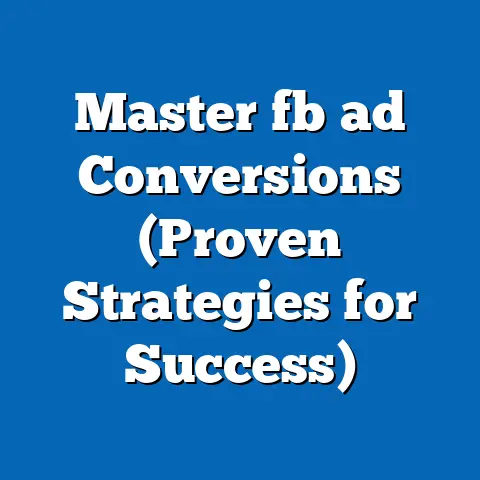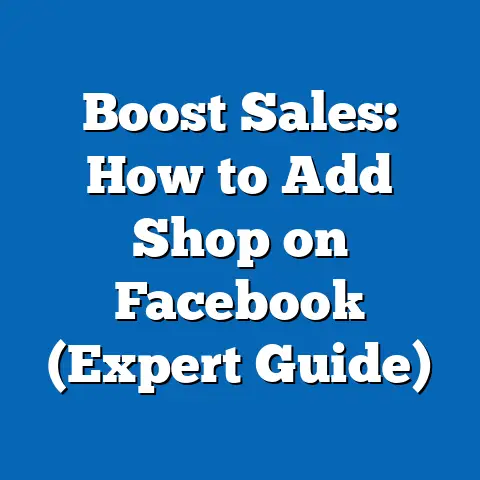Unlock Winning Facebook Mobile Ad Examples (Expert Insights)
In the ever-evolving landscape of digital marketing, few platforms have demonstrated the endurance and adaptability of Facebook, particularly in the realm of mobile advertising. Since its inception as a social networking site in 2004, Facebook has grown into a global powerhouse, boasting over 2.9 billion monthly active users as of 2023 (Statista, 2023). Its transition into a mobile-first platform, with more than 98% of its users accessing the site via mobile devices, underscores its ability to remain relevant across generational shifts and technological advancements.
This endurance is not merely a product of technological innovation but also a reflection of Facebook’s deep understanding of demographic trends and user behavior. From Baby Boomers to Gen Z, the platform has tailored its advertising strategies to resonate with diverse audiences, making it a critical tool for marketers aiming to connect with consumers on a personal level. This article delves into the defining characteristics of successful Facebook mobile ad campaigns, explores the historical context of the platform’s evolution, and examines the societal implications of its advertising dominance, with a particular focus on generational dynamics.
Defining Characteristics of Facebook Mobile Advertising
Facebook mobile advertising stands out for its precision targeting, interactive formats, and data-driven optimization. The platform’s ability to harness vast amounts of user data—ranging from demographics to behavioral patterns—allows advertisers to create highly personalized campaigns. For instance, features like Custom Audiences and Lookalike Audiences enable brands to target users based on past interactions or similarities to existing customers, a tactic that has proven effective across age groups.
Another key characteristic is the emphasis on visual and interactive content. With mobile users often scrolling through feeds at a rapid pace, formats like video ads, carousel ads, and Stories have become essential for capturing attention. According to a 2022 study by Hootsuite, video ads on Facebook generate 59% more engagement than static image ads, a trend that holds true for both younger users (Gen Z) and older demographics (Baby Boomers) who increasingly consume content on mobile devices.
Finally, affordability and scalability define Facebook mobile ads as a versatile tool for businesses of all sizes. Unlike traditional media, where high costs often exclude small players, Facebook’s ad platform allows for micro-budgeting, with campaigns starting at just a few dollars per day. This democratization of advertising has profound implications for market competition and brand visibility, particularly as different generations engage with digital content in unique ways.
Historical Context: The Evolution of Facebook and Mobile Advertising
To fully grasp the endurance of Facebook mobile advertising, it is essential to consider the platform’s historical trajectory and the broader societal shifts that shaped its growth. Launched in 2004 by Mark Zuckerberg as a college networking site, Facebook initially catered to a narrow demographic of young adults. Its expansion to a wider audience in 2006 coincided with the rise of the internet as a cultural and economic force, particularly among Millennials, who were coming of age during this period.
The introduction of the Facebook Ads platform in 2007 marked a turning point, transforming the site from a social hub into a commercial powerhouse. Early ads were rudimentary, often consisting of simple banner displays, but they laid the groundwork for more sophisticated targeting as user data accumulated. The shift to mobile advertising gained momentum with the widespread adoption of smartphones in the late 2000s and early 2010s, a period when Gen X and Millennials became the primary drivers of mobile internet usage.
Significant events, such as the 2012 acquisition of Instagram and the subsequent integration of cross-platform advertising, further solidified Facebook’s dominance in the mobile ad space. The platform adapted to changing user behaviors by prioritizing mobile-first design, a move that proved prescient as Gen Z emerged as a mobile-native generation. Today, with older generations like Baby Boomers increasingly adopting smartphones, Facebook’s ability to cater to a multi-generational audience through mobile ads is a testament to its strategic foresight.
Economic and technological factors also played a critical role in shaping this evolution. The 2008 financial crisis, for instance, pushed businesses to seek cost-effective marketing solutions, accelerating the shift to digital platforms like Facebook. Meanwhile, advancements in AI and machine learning enabled the platform to refine its ad algorithms, ensuring relevance across diverse user groups. These historical developments highlight how external forces and internal innovations have contributed to Facebook’s lasting impact on advertising.
Societal Implications of Facebook Mobile Advertising
The societal impact of Facebook mobile advertising extends far beyond marketing metrics, influencing cultural norms, economic structures, and even political landscapes across generations. At a cultural level, the platform has redefined how individuals interact with brands, fostering a more direct and interactive relationship. For younger users like Gen Z, who value authenticity, this has led to the rise of influencer marketing and user-generated content as key ad strategies.
Economically, Facebook mobile ads have lowered barriers to entry for entrepreneurs and small businesses, enabling them to compete with larger corporations. This democratization has been particularly significant for Millennials, many of whom launched startups during the post-recession recovery and relied on affordable digital ads to build their brands. However, this also raises concerns about market saturation and the potential for ad fatigue among users bombarded with constant promotions.
Politically, the platform’s role in shaping public opinion through targeted ads has sparked intense debate, particularly following events like the 2016 U.S. presidential election and the Cambridge Analytica scandal. These controversies highlight the ethical challenges of data-driven advertising, especially as different generations exhibit varying levels of trust in digital platforms. While Baby Boomers may be more susceptible to misinformation due to lower digital literacy, Gen Z often demands greater transparency and accountability from tech giants like Facebook.
The implications for privacy are equally significant. With each generation expressing unique concerns—Boomers prioritizing security, Millennials balancing convenience and privacy, and Gen Z advocating for data rights—Facebook must navigate a complex landscape to maintain user trust. These societal dynamics underscore the platform’s broader role as a cultural and economic force, shaping how generations perceive and engage with the digital world.
Winning Facebook Mobile Ad Examples: Expert Insights
To understand what makes a Facebook mobile ad campaign successful, we turn to expert insights and real-world examples that have resonated across generational lines. Below, we analyze several standout campaigns, focusing on their strategies, target demographics, and measurable outcomes. These examples illustrate how brands can leverage Facebook’s tools to create impactful ads tailored to diverse audiences.
Example 1: Nike’s “Just Do It” Mobile Video Campaign
Nike’s long-running “Just Do It” campaign has consistently adapted to digital platforms, with its mobile video ads on Facebook achieving remarkable engagement. Targeting primarily Millennials and Gen Z, the campaign uses short, inspirational videos featuring athletes and everyday individuals overcoming challenges. According to social media analyst Sarah Johnson, “Nike excels at storytelling, which resonates with younger audiences who value purpose-driven content over overt sales pitches.”
The campaign’s success lies in its use of emotional appeal and mobile-optimized formats like vertical videos, which align with how users consume content on smartphones. Metrics from a 2021 iteration revealed a 35% increase in brand recall among 18-34-year-olds, demonstrating the power of aligning ad content with generational values like self-expression and inclusivity.
Example 2: AARP’s Targeted Ads for Baby Boomers
While often associated with younger demographics, Facebook has proven effective for reaching older generations, as evidenced by AARP’s mobile ad campaigns. Targeting Baby Boomers, AARP uses carousel ads to promote services like retirement planning and health insurance, with clear calls-to-action tailored to this demographic’s preference for straightforward messaging. Digital marketing expert Michael Lee notes, “AARP understands that Boomers are active on mobile but require content that feels trustworthy and relevant to their life stage.”
By leveraging Facebook’s detailed demographic targeting, AARP achieved a 20% click-through rate increase in 2022 compared to previous campaigns. This example highlights the importance of customization and the platform’s versatility in addressing the needs of older users, who represent a growing segment of mobile internet users.
Example 3: Glossier’s Community-Driven Ads for Gen Z
Beauty brand Glossier has mastered the art of engaging Gen Z through community-driven Facebook mobile ads. By featuring user-generated content and interactive polls in Stories, Glossier taps into this generation’s desire for authenticity and co-creation. Marketing consultant Emily Chen states, “Glossier’s approach feels less like advertising and more like a conversation, which is key to building trust with younger users.”
The results speak for themselves: a 2020 campaign saw a 40% engagement rate among 18-24-year-olds, far surpassing industry averages. This success underscores the value of aligning ad strategies with generational expectations, particularly for Gen Z, who prioritize brands that reflect their social and cultural values.
Cross-Generational Strategies: Coca-Cola’s “Share a Coke” Campaign
Some campaigns manage to bridge generational divides, as seen in Coca-Cola’s “Share a Coke” mobile ads. By personalizing bottles with names and encouraging users to share photos on social media, the campaign appealed to Millennials’ love of personalization and Gen Z’s focus on social sharing, while still resonating with older generations through nostalgic branding. Advertising expert David Patel remarks, “Coca-Cola’s ability to create a unified message while allowing for personal interpretation is a masterclass in cross-generational marketing.”
The campaign’s mobile ads, which included interactive elements like name searches, generated millions of user interactions across age groups. This example illustrates how universal themes, combined with targeted execution, can create broad appeal on a platform like Facebook.
Generational Dynamics in Facebook Mobile Advertising
Understanding generational dynamics is crucial for crafting effective Facebook mobile ad campaigns, as each cohort brings unique values, behaviors, and technological preferences to the table. Below, we explore how Baby Boomers, Gen X, Millennials, and Gen Z interact with mobile ads, drawing on both qualitative insights and quantitative data.
Baby Boomers (Born 1946-1964)
Baby Boomers, often characterized by their post-war optimism and traditional values, have become an increasingly important demographic for mobile advertising. While historically less tech-savvy, their adoption of smartphones has surged, with 68% of U.S. Boomers owning a smartphone in 2023 (Pew Research Center). They tend to respond well to ads that emphasize trust, reliability, and clear benefits, often engaging with content related to health, finance, and family.
However, challenges remain, including lower tolerance for complex ad formats and heightened concerns about privacy. Marketers targeting Boomers must prioritize simplicity and transparency, ensuring ads feel informative rather than intrusive.
Generation X (Born 1965-1980)
Gen X, often described as the “forgotten generation,” serves as a bridge between analog and digital worlds. Having adapted to technology later in life, they are comfortable with mobile devices but value practicality over novelty. A 2022 survey by eMarketer found that 75% of Gen Xers use Facebook regularly, often engaging with ads for home improvement, travel, and professional services.
This generation appreciates a balance of creativity and utility in ads, responding well to formats like carousel ads that showcase product variety. Their dual role as parents and professionals also makes them a key target for family-oriented and career-focused campaigns.
Millennials (Born 1981-1996)
Millennials, the first generation to grow up with the internet, are a cornerstone of Facebook’s user base, though their engagement has slightly declined with the rise of platforms like Instagram and TikTok. Known for valuing experiences over possessions, they respond to ads that emphasize social impact, personalization, and storytelling. A 2021 report by Sprout Social revealed that 60% of Millennials are likely to purchase from brands they follow on social media if the content feels authentic.
Mobile video ads and influencer partnerships are particularly effective for this cohort, though ad fatigue is a growing concern. Brands must focus on creating meaningful connections rather than relying on repetitive promotions.
Generation Z (Born 1997-2012)
Gen Z, the true digital natives, approach mobile advertising with a critical eye, prioritizing authenticity and social responsibility. With 90% accessing Facebook via mobile devices (Statista, 2023), they are a vital demographic, though they also spend significant time on newer platforms. They engage most with short-form content like Stories and interactive ads that invite participation.
This generation’s skepticism toward traditional marketing means brands must build trust through transparency and alignment with social causes. Ads that feel overly polished or sales-driven often fail to resonate, as Gen Z values peer recommendations and user-generated content over corporate messaging.
Comparative Analysis: Generational Responses to Mobile Ads
While each generation exhibits distinct preferences, certain trends cut across age groups, offering valuable insights for advertisers. For instance, the preference for video content is nearly universal, though the type of video varies—Boomers favor informational clips, while Gen Z seeks entertainment. Similarly, trust remains a critical factor, though it manifests differently: Boomers look for established brand credibility, Millennials seek social proof, and Gen Z demands ethical practices.
Economic factors also influence ad responses. Millennials and Gen X, often burdened by financial responsibilities like mortgages or student debt, are more price-sensitive, responding to promotions and discounts. In contrast, Gen Z, with less disposable income but greater cultural influence, often drives trends through viral content, even if they don’t convert immediately.
Technological comfort levels further shape engagement. While Boomers may struggle with interactive formats, younger generations expect seamless, gamified experiences. These differences highlight the need for segmented strategies that respect generational diversity without resorting to oversimplified assumptions.
Technological, Economic, and Cultural Influences on Ad Effectiveness
The success of Facebook mobile ads is deeply tied to broader technological, economic, and cultural trends that vary across generations. Technologically, the rise of 5G and improved mobile interfaces have enhanced ad delivery, making high-quality video and AR experiences more accessible. This benefits younger users who expect cutting-edge formats, though it risks alienating older demographics less accustomed to rapid tech changes.
Economically, the post-pandemic recovery has influenced ad strategies, with a 2022 McKinsey report noting increased consumer spending on digital platforms across all age groups. However, inflation and economic uncertainty disproportionately affect Millennials and Gen X, prompting a shift toward value-driven ads. Meanwhile, Gen Z’s focus on sustainability reflects a cultural push for brands to address environmental and social issues, a trend less pronounced among older generations.
Culturally, the global nature of Facebook means ads must navigate diverse norms and values. For instance, humor that resonates with American Millennials may fall flat with Boomers in other regions. Successful campaigns balance universal themes with localized execution, ensuring relevance across both generational and geographic lines.
Nuances and Diversity Within Generations
While generational analysis provides a useful framework, it is critical to acknowledge the diversity within each cohort. Not all Baby Boomers are tech-averse; many are active online and embrace mobile ads with enthusiasm. Similarly, not every Gen Z user prioritizes social causes—economic constraints or personal interests often shape individual responses.
Factors like income, education, and cultural background further complicate generational trends. A high-income Millennial may engage with luxury brand ads, while a lower-income peer focuses on discounts, despite sharing similar formative experiences. Marketers must use Facebook’s targeting tools to account for these nuances, ensuring campaigns resonate on a personal level rather than relying on broad stereotypes.
Implications for Society, Culture, and the Workplace
The dominance of Facebook mobile advertising carries far-reaching implications for society and culture, particularly as generational interactions evolve. Socially, the platform’s role in shaping consumer behavior influences everything from purchasing decisions to political opinions, often amplifying generational divides. For instance, targeted ads can reinforce echo chambers, as algorithms prioritize content aligned with existing beliefs, a concern across all age groups.
Culturally, the emphasis on visual and interactive ads has shifted storytelling norms, with brands adopting more conversational tones to appeal to younger users. This trend challenges traditional marketing paradigms, forcing industries to adapt or risk obsolescence. It also raises questions about authenticity, as generations like Gen Z push back against overly curated content.
In the workplace, Facebook mobile ads have transformed how businesses recruit and engage employees. Job ads targeting Gen X and Millennials often highlight stability and benefits, while those for Gen Z emphasize flexibility and purpose. This generational tailoring reflects broader shifts in workplace values, with implications for talent retention and corporate culture.
Forward-Looking Insights: The Future of Facebook Mobile Advertising
Looking ahead, the future of Facebook mobile advertising will likely be shaped by technological innovation, regulatory changes, and evolving generational dynamics. The rise of the Metaverse, spearheaded by Meta (Facebook’s parent company), could redefine ad formats, offering immersive experiences that appeal to tech-savvy Gen Z while potentially alienating older users. Similarly, advancements in AI will enable even more precise targeting, though this must be balanced against growing privacy concerns.
Regulatory pressures, such as the EU’s General Data Protection Regulation (GDPR) and potential U.S. legislation, may limit data collection, forcing advertisers to prioritize first-party data and creative storytelling. This shift could benefit brands that build genuine connections, a priority for younger generations, but may challenge those reliant on broad data-driven strategies.
Generational transitions will also play a role, as Gen Alpha (born after 2012) begins to influence digital trends. Their expectations for seamless, interactive content will push Facebook to innovate, even as it retains older users through familiar formats. However, uncertainties remain, including competition from platforms like TikTok and potential shifts in user trust following privacy scandals.
Conclusion
Facebook mobile advertising exemplifies endurance in a rapidly changing digital landscape, adapting to generational shifts through precision targeting, interactive formats, and data-driven insights. From historical milestones like the smartphone boom to societal impacts on privacy and culture, the platform’s journey reflects broader trends in technology and human behavior. Winning campaigns, such as those by Nike, AARP, Glossier, and Coca-Cola, demonstrate the power of aligning strategies with generational values while respecting diversity within cohorts.
As we look to the future, the interplay of innovation and regulation will shape Facebook’s role in mobile advertising, with implications for how generations connect with brands and each other. While challenges like ad fatigue and privacy concerns persist, the platform’s ability to evolve offers hope for sustained relevance. By embracing nuance and prioritizing authenticity, marketers can unlock the full potential of Facebook mobile ads, fostering meaningful engagement across the generational spectrum.






